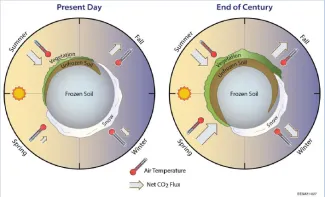Regional modeling study shows that twenty-first century climate warming will shift the seasonality of the carbon cycle across Alaska.
In high-latitude ecosystems, sunlight and air temperature change dramatically with the seasons. Summer days are warm and long, whereas winter days are freezing and short. Plants and microbes are most active in the summer. Recent observations and modeling studies have demonstrated that ongoing and projected climate change will increase plant productivity, microbial respiration, and growing season lengths at high latitudes. However, impacts on high-latitude carbon cycle seasonality remain uncertain. In this study, ecosys, a well-tested and process-rich mechanistic ecosystem model, was used to explore how climate warming will shift carbon cycle seasonality in Alaska throughout the twenty-first century. Model performance was evaluated using site and regional data products. Although recently reported large carbon losses during the fall and winter were successfully reproduced, the model still predicts a high-latitude carbon sink, indicating a resolution of current conflicts between modeled and observation-based estimates of high-latitude carbon balance. The team found that warming will result in surprisingly large changes in carbon cycle seasonality, with spring net carbon uptake overtaking summer net carbon uptake by 2100. This shift is driven by a factor of 3 relaxation of spring temperature limitation to plant productivity that results in earlier carbon uptake and a corresponding increase in spring net carbon uptake from 19 to 144 g C m-2 season-1 by the end of the century. Additionally, warmer soil temperatures and increased carbon inputs will lead to combined fall and winter carbon losses (163 g C m-2) that are larger than summer net uptake (123 g C m-2 season-1) by 2100. However, this increase in microbial activity leads to more rapid nitrogen cycling and increased plant nitrogen uptake during the fall and winter, which supports large increases in spring plant productivity. These results suggest that the high latitudes will continue to accumulate carbon throughout this century.
Citation: Shirley, I. A., Z. A. Mekonnen, R. F. Grant, B. Dafflon, S. S. Hubbard, and W. J. Riley. 2022. “Rapidly changing high-latitude seasonality: Implications for the 21st century carbon cycle in Alaska.” Environmental Research Letters 17: 014032. https://doi.org/10.1088/1748-9326/ac4362.


